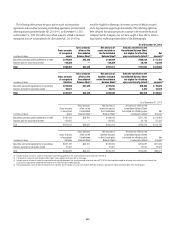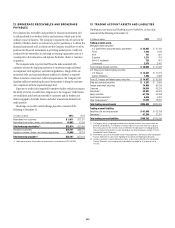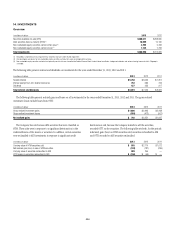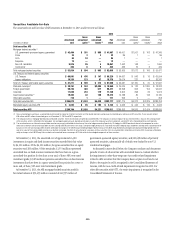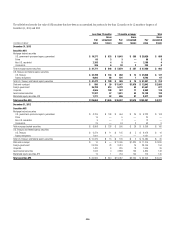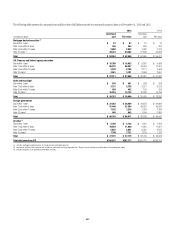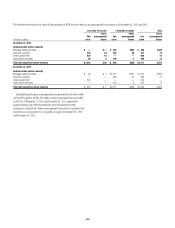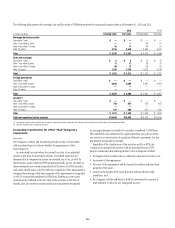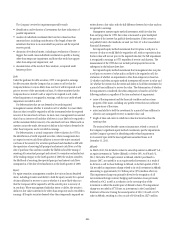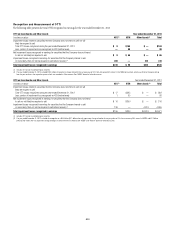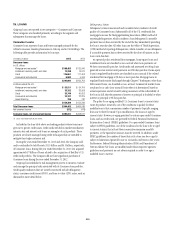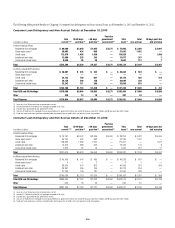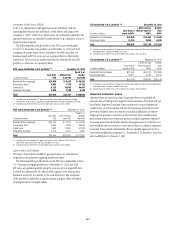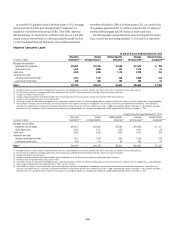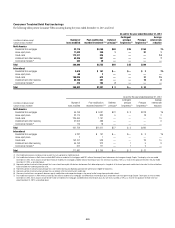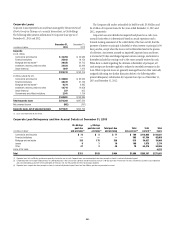Citibank 2013 Annual Report Download - page 229
Download and view the complete annual report
Please find page 229 of the 2013 Citibank annual report below. You can navigate through the pages in the report by either clicking on the pages listed below, or by using the keyword search tool below to find specific information within the annual report.211
The Company’s review for impairment generally entails:
• identification and evaluation of investments that have indications of
possible impairment;
• analysis of individual investments that have fair values less than
amortized cost, including consideration of the length of time the
investment has been in an unrealized loss position and the expected
recovery period;
• discussion of evidential matter, including an evaluation of factors or
triggers that could cause individual investments to qualify as having
other-than-temporary impairment and those that would not support
other-than-temporary impairment; and
• documentation of the results of these analyses, as required under
business policies.
Debt
Under the guidance for debt securities, OTTI is recognized in earnings
for debt securities that the Company has an intent to sell or that the
Company believes it is more-likely-than-not that it will be required to sell
prior to recovery of the amortized cost basis. For those securities that the
Company does not intend to sell or expect to be required to sell, credit-
related impairment is recognized in earnings, with the non-credit-related
impairment recorded in AOCI.
For debt securities that are not deemed to be credit impaired,
management assesses whether it intends to sell or whether it is more-likely-
than-not that it would be required to sell the investment before the expected
recovery of the amortized cost basis. In most cases, management has asserted
that it has no intent to sell and that it believes it is not likely to be required to
sell the investment before recovery of its amortized cost basis. Where such an
assertion cannot be made, the security’s decline in fair value is deemed to be
other than temporary and is recorded in earnings.
For debt securities, a critical component of the evaluation for OTTI is
the identification of credit impaired securities, where management does
not expect to receive cash flows sufficient to recover the entire amortized
cost basis of the security. For securities purchased and classified as AFS with
the expectation of receiving full principal and interest cash flows as of the
date of purchase, this analysis considers the likelihood and the timing of
receiving all contractual principal and interest. For securities reclassified out
of the trading category in the fourth quarter of 2008, the analysis considers
the likelihood of receiving the expected principal and interest cash flows
anticipated as of the date of reclassification in the fourth quarter of 2008.
Equity
For equity securities, management considers the various factors described
above, including its intent and ability to hold the equity security for a period
of time sufficient for recovery to cost or whether it is more-likely-than-not
that the Company will be required to sell the security prior to recovery of
its cost basis. Where management lacks that intent or ability, the security’s
decline in fair value is deemed to be other-than-temporary and is recorded in
earnings. AFS equity securities deemed other-than-temporarily impaired are
written down to fair value, with the full difference between fair value and cost
recognized in earnings.
Management assesses equity method investments with fair value less
than carrying value for OTTI. Fair value is measured as price multiplied
by quantity if the investee has publicly listed securities. If the investee is
not publicly listed, other methods are used (see Note 25 to the Consolidated
Financial Statements).
For impaired equity method investments that Citi plans to sell prior to
recovery of value or would likely be required to sell, with no expectation that
the fair value will recover prior to the expected sale date, the full impairment
is recognized in earnings as OTTI regardless of severity and duration. The
measurement of the OTTI does not include partial projected recoveries
subsequent to the balance sheet date.
For impaired equity method investments that management does not plan
to sell prior to recovery of value and is not likely to be required to sell, the
evaluation of whether an impairment is other-than-temporary is based on
(i) whether and when an equity method investment will recover in value and
(ii) whether the investor has the intent and ability to hold that investment for
a period of time sufficient to recover the value. The determination of whether
the impairment is considered other-than-temporary is based on all of the
following indicators, regardless of the time and extent of impairment:
• cause of the impairment and the financial condition and near-term
prospects of the issuer, including any specific events that may influence
the operations of the issuer;
• intent and ability to hold the investment for a period of time sufficient to
allow for any anticipated recovery in market value; and
• length of time and extent to which fair value has been less than the
carrying value.
The sections below describe current circumstances related to certain of
the Company’s significant equity method investments, specific impairments
and the Company’s process for identifying credit-related impairments
in its security types with the most significant unrealized losses as of
December 31, 2013.
Akbank
In March 2012, Citi decided to reduce its ownership interest in Akbank T.A.S.,
an equity investment in Turkey (Akbank), to below 10%. As of March 31,
2012, Citi held a 20% equity interest in Akbank, which it purchased in
January 2007, accounted for as an equity method investment. As a result of
its decision to sell its share holdings in Akbank, in the first quarter of 2012
Citi recorded an impairment charge related to its total investment in Akbank
amounting to approximately $1.2 billion pretax ($763 million after-tax).
This impairment charge was primarily driven by the recognition of all
net investment foreign currency hedging and translation losses previously
reflected in AOCI, as well as a reduction in the carrying value of the
investment to reflect the market price of Akbank’s shares. The impairment
charge was recorded in OTTI losses on investments in the Consolidated
Statement of Income. During the second quarter of 2012, Citi sold a 10.1%
stake in Akbank, resulting in a loss on sale of $424 million ($274 million



